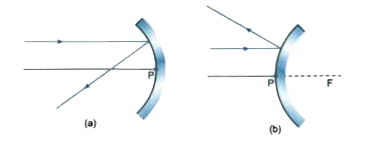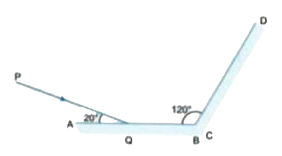Complete Solutions to HOTS (HIGHER ORDER THINKING SKILLS) of chapter LIGHT-REFLECTION AND REFRACTION of Class 10 book with complete answers and questions
| Class 10 | PHYSICS |
| Chapter | LIGHT-REFLECTION AND REFRACTION |
| VK GLOBAL PUBLICATION | HOTS (HIGHER ORDER THINKING SKILLS) |
| Number Of Questions | 23 |
| Academic Year | 2023-24 |
Which one of the two-glass and water is optically denser and why?
View SolutionWhy does white light split up into different colours while passing through a glass prism?
View SolutionCan a convergent lens in one medium become divergent in another medium?
View SolutionA man is going away from the plane mirror with a velocity of 3 m/s. With what velocity is he going away from his own image in the mirror?
View SolutionUnder what condition a convex lens when placed in a medium behaves as an ordinary glass plate?
View SolutionWhy does a concave mirror has a real principal focus ?
View SolutionA concave mirror and convex lens are immersed in water. What change, if any, do you expect in the focal length of the two?
View SolutionWhich is a better reflector-a plane mirror or a right-angled prism?
View SolutionA man is holding a lighted candle in front of a thick glass mirror and on viewing it obliquely he noticed a number of images of the candle why ?
View SolutionA concave mirror of focal length f produces an image n times the size of the object . What would be the object distance for which the image is real ?
View SolutionIn the following figures, one les is places inside each box. State the nature of the lens. Complete the ray diagrams.

View SolutionA convex lens forms a blurred image of an object on a screen.
Suggest a suitable way to get a sharp image on a screen without disturbing the object , lens or the screen.
View SolutionWhy does a ray of light parallel to the principal axis
(i) bend towards the principal axis in the case of a concave mirror and
(ii) goes away from the principal axis in the case of convex mirror as shown here ?
View SolutionThe ray diagrams given below show the paths of a ray of light travelling from a medium Minto different media 1, 2 and 3.

(a) In which of three media 1, 2 or 3 does light travel: (i) faster, (ii) slower than in medium M?
(b) Arrange the media 1, 2 and 3 in descending order of (i) speed of light through them, (ii) their refractive index.
View SolutionIf x , y and z denote the object distance, image distance and the radius of curvature respectively of a spherical mirror, which one of the following is the correct relation between them ?
View SolutionYou are given lenses with powers + 10 D, + 5 D , - 5 D, - 20 D , and -10 D . Taking a pair of lenses at a time , which two lenses will you select to have a combination of total focal length when the two lenses are kept in contact in each case.
View SolutionA student recorded the following data for the values of object distance and corresponding image distance while performing an experiment on real image formatio lens of power + 4 D. Two of these observations are incorrect. Without making any calculations, identify these observations and give reason for your choice.

View SolutionThe given ray diagram shows a ray of light PQ striking a mirror AB. The mirror AB and CD are at an angle of `120^@` with each other. The ray PQ strikes the surface of the mirror AB at point Q.
(i) Draw the complete path of reflection of the ray at mirrors AB and CD.
(ii) Calculate the sum of angles which the reflected rays make with the surfaces of mirrors AB and CD.

View SolutionCompare and contrast between the image formation by a concave and convex mirror. Write the similarities in the common space and the dissimilarities in the left side or the right side.

View SolutionPlaying with an old lens one morning, Ravi discovers that if he holds the lens 10 cm away from a wall opposite to a window, he can see a sharp but upside-down picture of outside world on the wall. That evening, he covers a lighted lamp with a piece of opaque paper on which he has pierced, a small hole 1 mm in diameter. By placing the lens between the illuminated card and the wall, he manages to produce a sharp image of diameter 5 mm on the wall.
What is the power of the lens ?
View SolutionPlaying with an old lens one morning, Ravi discovers that if he holds the lens 10 cm away from a wall opposite to a window, he can see a sharp but upside-down picture of outside world on the wall. That evening, he covers a lighted lamp with a piece of opaque paper on which he has pierced, a small hole 1 mm in diameter. By placing the lens between the illuminated card and the wall, he manages to produce a sharp image of diameter 5 mm on the wall.
In the evening experiment , how far away from the opaque paper did he place the lens ?
View SolutionPlaying with an old lens one morning, Ravi discovers that if he holds the lens 10 cm away from a wall opposite to a window, he can see a sharp but upside-down picture of outside world on the wall. That evening, he covers a lighted lamp with a piece of opaque paper on which he has pierced, a small hole 1 mm in diameter. By placing the lens between the illuminated card and the wall, he manages to produce a sharp image of diameter 5 mm on the wall.
How far apart were the card and the wall ?
View SolutionIf the image formed by a lens for all positions of the object placed in front of it is always virtual, erect and diminished, state the type of the lens. Draw a ray diagram in support of your answer. If the numerical value of focal length of such a lens is 20 cm, find its power in new cartesian sign conventions.
View Solution
HOTS (HIGHER ORDER THINKING SKILLS) questions and complete solutions for chapter LIGHT-REFLECTION AND REFRACTION of VK GLOBAL PUBLICATION PHYSICS (HINGLISH) of Class 10
All Exercises from VK GLOBAL PUBLICATION Class 10 PHYSICS LIGHT-REFLECTION AND REFRACTION
- HOTS (HIGHER ORDER THINKING SKILLS)
- LONG ANSWER QUESTIONS
- NCERT Exercises
- NCERT INTEXT QUESTIONS
- PROFICIENCY EXERCISE (Long Answer Questions)
- PROFICIENCY EXERCISE (Short Answer Questions-I)
- SHORT ANSEWR QUESTIONS-I
- SHORT ANSEWR QUESTIONS-II
- SOME IMPORTANT NUMERICALS
- SOME IMPORTANT NUMERICALS (FOR PRACTICE)
- VERY SHORT ANSEWR QUESTIONS